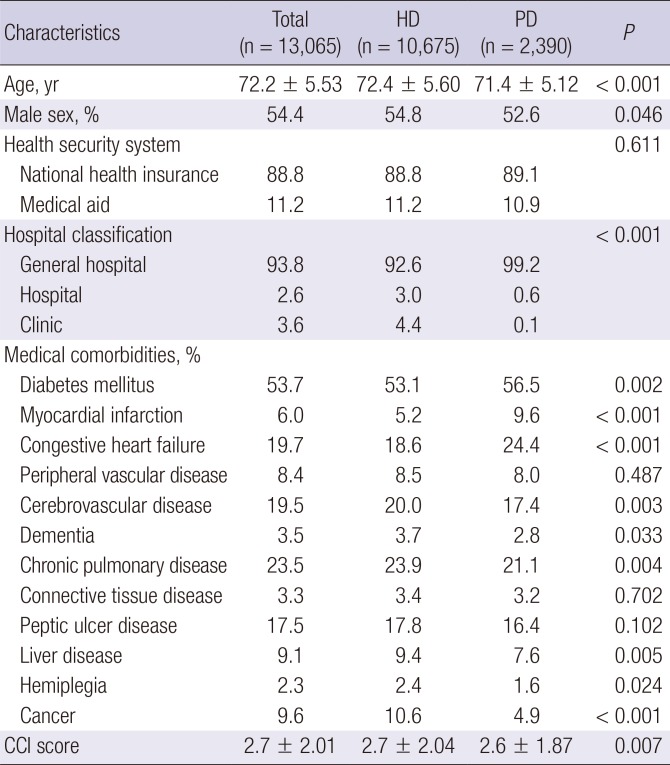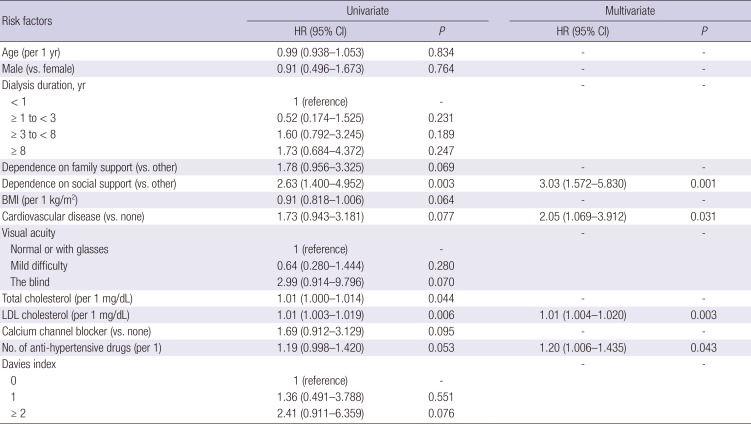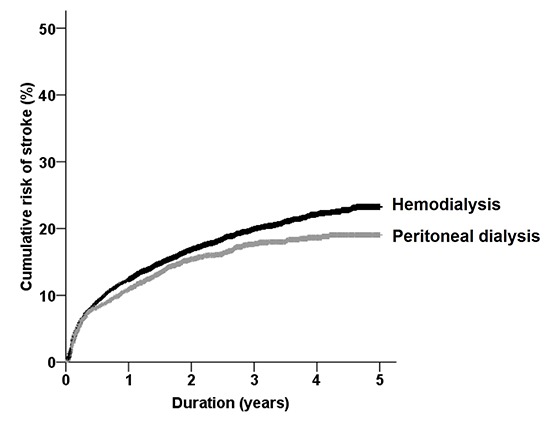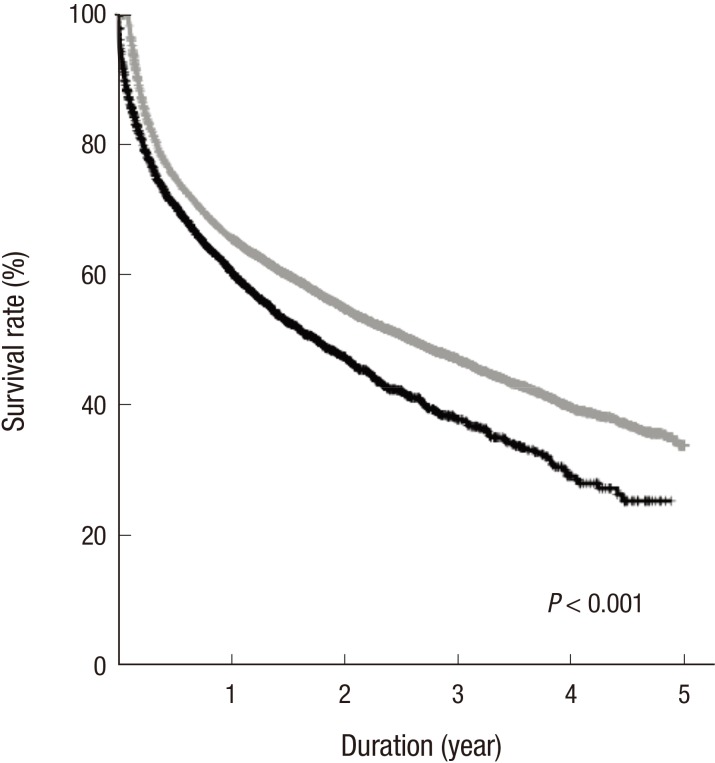1. Brønnum-Hansen H, Davidsen M, Thorvaldsen P; Danish MONICA Study Group. Long-term survival and causes of death after stroke. Stroke. 2001; 32(9):2131–2136. PMID:
11546907.
2. Di Carlo A. Human and economic burden of stroke. Age Ageing. 2009; 38:4–5. PMID:
19141505.
3. Redón J, Cea-Calvo L, Lozano JV, Martí-Canales JC, Llisterri JL, Aznar J, González-Esteban J. Investigators of the PREV-ICTUS study. Blood pressure and estimated risk of stroke in the elderly population of Spain: the PREV-ICTUS study. Stroke. 2007; 38:1167–1173. PMID:
17322073.
4. Chen X, Zhou L, Zhang Y, Yi D, Liu L, Rao W, Wu Y, Ma D, Liu X, Zhou XH, et al. Risk factors of stroke in Western and Asian countries: a systematic review and meta-analysis of prospective cohort studies. BMC Public Health. 2014; 14:776. PMID:
25081994.
5. Schiffrin EL, Lipman ML, Mann JF. Chronic kidney disease: effects on the cardiovascular system. Circulation. 2007; 116:85–97. PMID:
17606856.
6. Seliger SL, Gillen DL, Longstreth WT Jr, Kestenbaum B, Stehman-Breen CO. Elevated risk of stroke among patients with end-stage renal disease. Kidney Int. 2003; 64:603–609. PMID:
12846756.
7. Stevens LA, Viswanathan G, Weiner DE. Chronic kidney disease and end-stage renal disease in the elderly population: current prevalence, future projections, and clinical significance. Adv Chronic Kidney Dis. 2010; 17:293–301. PMID:
20610356.
8. Han SS, Park JY, Kang S, Kim KH, Ryu DR, Kim H, Joo KW, Lim CS, Kim YS, Kim DK. Dialysis modality and mortality in the elderly: a meta-analysis. Clin J Am Soc Nephrol. 2015; 10:983–993. PMID:
25941194.
9. Quan H, Sundararajan V, Halfon P, Fong A, Burnand B, Luthi JC, Saunders LD, Beck CA, Feasby TE, Ghali WA. Coding algorithms for defining comorbidities in ICD-9-CM and ICD-10 administrative data. Med Care. 2005; 43:1130–1139. PMID:
16224307.
10. Hemmelgarn BR, Manns BJ, Quan H, Ghali WA. Adapting the Charlson Comorbidity Index for use in patients with ESRD. Am J Kidney Dis. 2003; 42:125–132. PMID:
12830464.
11. Davies SJ, Russell L, Bryan J, Phillips L, Russell GI. Comorbidity, urea kinetics, and appetite in continuous ambulatory peritoneal dialysis patients: their interrelationship and prediction of survival. Am J Kidney Dis. 1995; 26:353–361. PMID:
7645541.
12. Hemodialysis Adequacy 2006 Work Group. Clinical practice guidelines for hemodialysis adequacy, update 2006. Am J Kidney Dis. 2006; 48(Suppl 1):S2–S90. PMID:
16813990.
13. Korevaar JC, Feith GW, Dekker FW, van Manen JG, Boeschoten EW, Bossuyt PM, Krediet RT; NECOSAD Study Group. Effect of starting with hemodialysis compared with peritoneal dialysis in patients new on dialysis treatment: a randomized controlled trial. Kidney Int. 2003; 64:2222–2228. PMID:
14633146.
14. Selgas R, Cirugeda A, Fernandez-Perpén A, Sánchez-Tomero JA, Barril G, Alvarez V, Bajo MA. Comparisons of hemodialysis and CAPD in patients over 65 years of age: a meta-analysis. Int Urol Nephrol. 2001; 33:259–264. PMID:
12092638.
15. Locatelli F, Marcelli D, Conte F, D’Amico M, Del Vecchio L, Limido A, Malberti F, Spotti D. Survival and development of cardiovascular disease by modality of treatment in patients with end-stage renal disease. J Am Soc Nephrol. 2001; 12:2411–2417. PMID:
11675417.
16. Hiramatsu T, Furuta S, Kakuta H. Impact of dialysis modality on ultrasonographic cardiovascular parameters in elderly patients. Adv Perit Dial. 2007; 23:94–97. PMID:
17886611.
17. Johnson DW, Dent H, Hawley CM, McDonald SP, Rosman JB, Brown FG, Bannister K, Wiggins KJ. Association of dialysis modality and cardiovascular mortality in incident dialysis patients. Clin J Am Soc Nephrol. 2009; 4:1620–1628. PMID:
19729428.
18. Chavarria LA, Aguilar-Kitsu A, Rosas P, Fajardo A, Mendoza-Guevara L, Sanchez L, Zepeda C, Ibarra P, Luna A, Lindholm B, et al. Intima media thickness in children undergoing dialysis. Pediatr Nephrol. 2012; 27:1557–1564. PMID:
22552884.
19. Marrón B, Remón C, Pérez-Fontán M, Quirós P, Ortíz A. Benefits of preserving residual renal function in peritoneal dialysis. Kidney Int Suppl. 2008; S42–S51. PMID:
18379546.
20. McIntyre CW. Effects of hemodialysis on cardiac function. Kidney Int. 2009; 76:371–375. PMID:
19516249.
21. Seliger SL, Gillen DL, Tirschwell D, Wasse H, Kestenbaum BR, Stehman-Breen CO. Risk factors for incident stroke among patients with end-stage renal disease. J Am Soc Nephrol. 2003; 14:2623–2631. PMID:
14514741.
22. Meschia JF, Bushnell C, Boden-Albala B, Braun LT, Bravata DM, Chaturvedi S, Creager MA, Eckel RH, Elkind MS, Fornage M, et al. Guidelines for the primary prevention of stroke: a statement for healthcare professionals from the American Heart Association/American Stroke Association. Stroke. 2014; 45:3754–3832. PMID:
25355838.
23. Phillips SJ. Pathophysiology and management of hypertension in acute ischemic stroke. Hypertension. 1994; 23:131–136. PMID:
8282324.
24. Power A. Stroke in dialysis and chronic kidney disease. Blood Purif. 2013; 36:179–183. PMID:
24496188.
25. Shroff RC, McNair R, Figg N, Skepper JN, Schurgers L, Gupta A, Hiorns M, Donald AE, Deanfield J, Rees L, et al. Dialysis accelerates medial vascular calcification in part by triggering smooth muscle cell apoptosis. Circulation. 2008; 118:1748–1757. PMID:
18838561.
26. Demer LL, Tintut Y. Vascular calcification: pathobiology of a multifaceted disease. Circulation. 2008; 117:2938–2948. PMID:
18519861.
27. Zhang X, Patel A, Horibe H, Wu Z, Barzi F, Rodgers A, MacMahon S, Woodward M; Asia Pacific Cohort Studies Collaboration. Cholesterol, coronary heart disease, and stroke in the Asia Pacific region. Int J Epidemiol. 2003; 32(9):563–572. PMID:
12913030.
28. Iso H, Jacobs DR Jr, Wentworth D, Neaton JD, Cohen JD. Serum cholesterol levels and six-year mortality from stroke in 350,977 men screened for the multiple risk factor intervention trial. N Engl J Med. 1989; 320:904–910. PMID:
2619783.
29. Russo T, Felzani G, Marini C. Stroke in the very old: a systematic review of studies on incidence, outcome, and resource use. J Aging Res. 2011; 2011:108785. PMID:
21876804.
30. Fellström BC, Jardine AG, Schmieder RE, Holdaas H, Bannister K, Beutler J, Chae DW, Chevaile A, Cobbe SM, Grönhagen-Riska C, et al. Rosuvastatin and cardiovascular events in patients undergoing hemodialysis. N Engl J Med. 2009; 360:1395–1407. PMID:
19332456.
31. Baigent C, Landray MJ, Reith C, Emberson J, Wheeler DC, Tomson C, Wanner C, Krane V, Cass A, Craig J, et al. The effects of lowering LDL cholesterol with simvastatin plus ezetimibe in patients with chronic kidney disease (Study of Heart and Renal Protection): a randomised placebo-controlled trial. Lancet. 2011; 377:2181–2192. PMID:
21663949.
32. Clark AM, DesMeules M, Luo W, Duncan AS, Wielgosz A. Socioeconomic status and cardiovascular disease: risks and implications for care. Nat Rev Cardiol. 2009; 6:712–722. PMID:
19770848.









 PDF
PDF ePub
ePub Citation
Citation Print
Print






 XML Download
XML Download